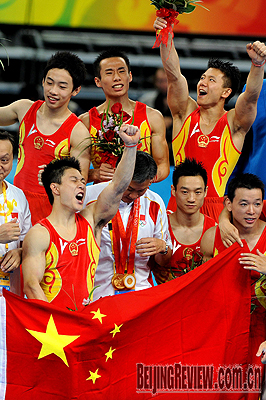|

The Beijing Olympic Village
A 6,000-square-meter solar heating system is capable of providing hot bathing water for 17,200 athletes in the Olympic Village and saving about 5 million kwh of energy every year. After the Olympics, this system will provide hot water for nearly 2,000 homes.
The low energy-consuming constructions in the Beijing Olympic Village can save 16,000 kwh of energy during the air-conditioning season. The system, which uses renewable energy, takes 7.89 million kwh from the sun and renewable water supplies during the Games, equal to the energy produced by 3,077 tons of coal. The use of this renewable energy reduces carbon dioxide emissions by 8,000 tons.
Western food makes up 70 percent of the dishes supplied in the Beijing Olympic Village and Asian food the remaining 30 percent.
Food was available 24 hours a day free of charge during the Olympics. Around 9,000 bananas, 700 roast ducks and three tons of rice were consumed every day.
From 10 a.m. to 7 p.m. on August 8, the opening day of the Beijing Olympics, the number of people who ate in the main athletes dining room at the Olympic Village was 18,634, the highest number in Olympic history.
Security
More than 30 medical teams consisting of over 3,000 members were responsible for medical security in Olympic venues and 24 appointed hospitals provided instant and all-round medical services for people from all over the world.
Audience
Nearly 120 broadcasting institutions and over 10,000 journalists as well as a television audience of 4 billion were able to watch the Olympics on high-definition televisions.
From August 8-24, an incredible number of people watched Olympic coverage broadcast by China Central Television across China. They included 93 percent of all urban residents and 91 percent of rural residents, 92 percent of men and 91 percent of women, 94 percent of people between 25 and 55, and 89 percent of people above 55 years of age.
During the first week of the Beijing Olympics, the number of people who visited the website of the International Olympic Committee (IOC) surpassed the total of the whole Athens Olympics. By the end of the Beijing Olympics, 5 million people had visited the IOC website, compared to 2.8 million during the Athens Games.
More than eighty percent of the 31 Beijing Olympic competition venues had an average attendance of 80 percent.
Athletes
The tallest athlete was 2.26-meter Yao Ming, the basketball player from Shanghai, who was the flag-bearer of China's athletics team at the opening ceremony.
The shortest athlete was 1.37-meter Deng Linlin, who is from China's Anhui Province and took part in the gymnastics competition.
The oldest athletes were 67-year-old Hiroshi Hoketsu, a male equestrian, and 58-year-old Mieko Yagi, a female equestrian, both from Japan.
The youngest athlete was Antoinette Guedia from Cameroon, who is just 12 years old. She took part in the women's 50-meter freestyle swimming competition.
There were altogether 5,000 drug tests conducted during the Olympics, and six positive.
Others
There were altogether 15,153 costumes of 47 different styles in the performance at the opening ceremony of the Beijing Olympics.
The weight of the giant scroll unraveled around the top of the arena during the opening ceremony was 800 kg.
There were altogether 500 cheering squads at this Olympics. | 